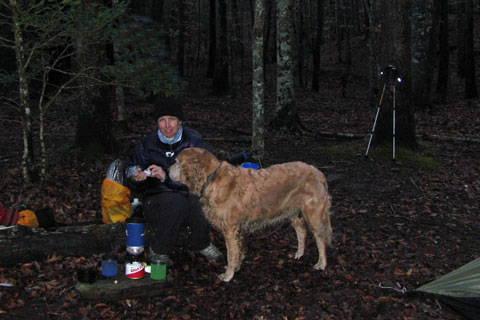| 339 | 10 Items for a Backcountry Kitchen |
2011-01-28 |

Before my wife and I met, I had been a bachelor for many years. I generally ate at home and always cooked my own meals. My meals were simple; but to me they were tasty. After combining our households in marriage I shared in the cooking duties. My plan was that I would make some of my old favorites and "wow" my wife with my culinary expertise. After a couple of fares, when I announced that I was going to cook dinner again, my wife informed me that I was not going to cook dinner, I was going to warm something for dinner.
So, if I only warm in the confines of a kitchen equipped with every convenience known to man, you can only imagine how I cook while backpacking... well, I boil water. In my defense I might say that I am very good at boiling water and I do like to keep the backcountry meals as simple as possible. My instructions are usually as follows: boil water, remove from heat, add ingredients (or water to ingredients), stir, let it stand, stir again, and eat. Viola! Dinner is served.
The items you need for a backcountry kitchen vary depending on the purpose of your trip. If you are for example, are going camping and while on the camping trip you plan to hike, climb, or fish a little during the day, then meals will be important events. You will have time to cook and should bring more kitchen wares. If instead you are going to spend the whole day hiking or climbing you will be too tired to cook. You will only need the bare essentials in your kitchen.
The top ten items to pack for a simple Backcountry Kitchen are:
10 - Food/Cooking Gear Storage Gear - A storage bag or container for carrying your food and cooking gear is an essential. Food and cooking gear has to be stored away from animals reach every night. Be sure and check the regulations to the area where you are going backcountry special bear proof containers might be required. Cord used to hang the bag would also be needed.
9 - Water Storage Container - A water bag or bottles to go to the creek and fetch water simplifies many kitchen duties. Remember, the kitchen should be 100 to 200 feet from the water source (different agencies require a different buffer distance.) It is probably easiest to filter or purify the water at the creek.
8 - Stove - If you are going to heat food you had better have a stove, fuel, and matches. Most popular backcountry areas do not allow fires.
7 - Pot w/Lid - A cooking pot with a lid and handle are all the cookware needed for a basic kitchen.
6 - Cup and bowl - Every camper needs a cup. It is probably preferable to have an insulated cup with a lid. The bowl is optional. If you are the only one eating the meal, then the cooking pot can be your bowl. Some folks prefer to use a large mug as a cup and a bowl.
5 - Spoon - You need a utensil to move the food from the bowl to your mouth. Some folks choose a spork. The spork tries to combine a spoon and a fork, in essence it is a spoon with tines. You should also carry a small knife.
4 - Condiments - Salt, pepper, garlic, etc stored in small bags will help flavor bland camp foods. Condiments are worth their weight, just don't take the whole McCormick rack of spices.
3 - Pot scrubber - If you cook anything other than boil water, there is probably some clean up involved. A small scrubber pad (cut to size), a scrapper blade, and camp soap are all the you need for most cleaning jobs. Boiling extra water helps with most clean up duties.
2 - Strainer and Waste Bag - To keep varmints from eating your food scraps, use a small piece of screen or cheesecloth to filter the dirty water as you rinse the cookware. Store the screen in the waste bag.
1 - Peanut Butter - When all else fails in a backcountry kitchen, just make sure that you have peanut butter as a back up. Pack the peanut butter in plastic bags. Tear a corner of the bag and serve. Squeeze the bag to deliver the nectar of the gods. For those who are allergic to peanuts, bring a peanut butter substitute, such as cheese, as a non-cooking, emergency food.
After a long hard day in the backcountry any food tastes good. A backcountry meal eaten at home might taste terrible; but when camping it becomes the best meal you have ever had! It is not about the food, it is the experience!
Remember to always practice the Leave No Trace Principles while camping and cooking.
Happy Backcountry Kitchen trails.
